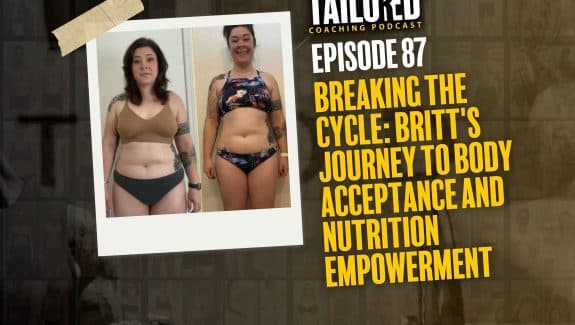Metabolic adaptation has many names. It is referred to as “starvation mode” or “metabolic damage” and is often called adaptive thermogenesis in the scientific literature. This makes it difficult to understand what metabolic adaptation actually entails. Some people think it means your metabolism is broken, but that’s not true. In this guide I’m going to explain the basics of metabolic adaptation using a deep-dive into the research, then end with a case-study so that you can apply the knowledge you learned to yourself or your clients.
What is metabolic adaptation?
To understand something we must first define it. Metabolic adaptation is the difference between expected and observed changes in energy expenditure during weight loss or weight gain. There are a number of factors that contribute to metabolic adaptation, those being: resting metabolic rate or basal metabolic rate (RMR/BMR), the thermic effect of feeding (TEF), exercise activity thermogenesis (EAT), and non-exercise adaptive thermogenesis (NEAT). These four components make up total daily energy expenditure (TDEE). Metabolic adaptation influences some of these components independently.
Basal metabolic rate and resting metabolic rate are used interchangeably by most people, so we’ll do the same here. There are some nuances between the two, but that isn’t important for now. BMR/RMR is the amount of energy expended by everything in the body at rest, essentially it is the amount of energy we need to maintain weight if we didn’t do any activity. BMR/RMR accounts for the majority of our daily energy expenditure (60-75%). When we lose weight our bodies become smaller, so we require less energy in the resting/basal state, which is one part of metabolic adaptation that occurs during weight loss. We cannot control how our body changes our BMR/RMR with weight loss. There is some individual variability involved too. We can only use exercise and nutrition choices to attenuate the reduction in BMR/RMR so that our body composition changes in an ideal way. For example, high protein diets tend to reduce the loss of lean mass when dieting. This is important because lean mass accounts for a large portion of our BMR/RMR and ~80% of our TDEE.
The thermic effect of food is the increase in metabolic rate after ingestion of a meal. Evidence suggests that TEF is influenced by macronutrient composition of the mail, meal size, and possibly age and physical activity level. It accounts for 5-10% of TDEE. High protein and higher carbohydrate meals increase TEF more than meals high in fat. When we lose weight we generally eat less, which means that TEF may decrease slightly. However, there isn’t any change in TEF that causes metabolic adaptation more than we would expect by eating less food, so we don’t need to worry about it for now — just make sure you’re eating a high protein diet because protein.
Exercise activity thermogenesis is the energy we expend when we exercise. This could be cardio, resistance training, or high intensity interval training. When trying to lose weight we may increase EAT, and as our body weight decreases we expend less energy for the same workout. Plus, our bodies adapt to exercise to become more mechanically and metabolically efficient so we use less energy. How unfortunate.
Non-exercise adaptive thermogenesis (NEAT) is the energy we use for everything that is not sleeping, eating, or exercise. NEAT accounts for 10-20% of overall TDEE. NEAT increases with overfeeding and decreases with dieting, and is the largest contributor to metabolic adaptation. In one study, non-resting energy expenditure accounted for a 300 calorie per day decrease after correcting for body weight. In some special cases NEAT can account for up to 30% of TDEE.
If you want an overview of the molecular mechanisms that drive metabolic adaptation, which include proton leak, brown adipose tissue activation, and hormones, Dr. Trexler provides an excellent analysis here. In our recently published review, we also highlight several mechanisms that explain how metabolic adaptation occurs. Some scientists have assumed that metabolic adaptation is an autoregulatory response explained by the reduced activity of the sympathetic nervous system and low plasma concentrations of T3 and leptin. Others see it as a protective survival mechanism against prolonged periods of caloric restriction, purported to be mediated by decreased leptin concentrations due to decreases in fat mass.
Why does metabolic adaptation occur?
Some scientists have postulated that metabolic adaptation is beneficial in reducing the rate of aging. Others have said metabolic adaptation is a way to reduce the gap between energy intake and expenditure, so further weight loss is prevented and the chance of survival is enhanced. This is great from an evolutionary perspective. We have a biological mechanism that stops us from expending energy we don’t necessarily have, or at least lowering our energy expenditure to help us survive longer. However, when dieting it means we have to fight against our mind and body to lose weight. In fact, it’s been estimated that for every 1 kilogram of weight loss, appetite increases 100 calories per day. So not only are we reducing our energy expenditure when dieting, but we’re increasing our drive to eat.
Who does metabolic adaptation effect?
Metabolic adaptation affects everyone trying to lose (or gain) weight. However, it affects some people more than others. The theory behind this is called the thrifty gene hypothesis. Essentially, it states that several thousand years ago, environmental pressures and natural selection would favor people who were able to survive long periods of famine when food was scarce. These people are the ones who prevailed and conformed to our genetic heritage, a heritage that when thrown in our modern obesogenic environment leads us to gain weight. This means that those who have a “thrifty” metabolism may have a more adaptive metabolism, which is a bad thing if you’re trying to lose weight. This can be seen in the amount of NEAT people expend. For example, some people can’t stop moving around (fidgeting, high-energy) so they burn a lot more calories than those who don’t move as much. There isn’t a good scientific explanation for why people behave differently, so future research is needed to determine if there is some type of genetic component. Luckily, we can engineer our environments to help us move more using some simple steps like parking far from stores, using the stairs, and having walking meetings/phone calls. Any method to help us move more can help prevent the reduction in NEAT that occurs when dieting.
When does metabolic adaptation occur?
Metabolic adaptation occurs fairly quickly. Some evidence suggests it starts to occur in as few as 3 days and is a significant contributor to TDEE in three to six weeks. Most of the literature uses percentage of body weight loss when measuring metabolic adaptation. For example, in the famous Leibel et al., (1995) study, 10% body weight loss resulted in ~250 calories of metabolic adaptation. In another study on contestants from The Biggest Loser, losing roughly 40% of body weight resulted in 500 calories of metabolic adaptation. Finally, a study by Nymo et al., (2018) found that 5% body weight loss caused a 75 calorie decrease in RMR, which increased to 125 calories when participants reached 10% weight loss. As I mentioned, there are larger changes in NEAT than RMR, so we have to interpret the Nymo et al., findings with caution when applying them. There is also some data to suggest that metabolic adaptation peaks at 10% weight loss. Part of estimating energy expenditure involves a physical activity factor (RMR * physical activity level = TDEE) so if we aren’t accounting for NEAT in our activity we could be missing a large portion of metabolic adaptation.
How long does metabolic adaptation last?
There’s a lot of controversy in the literature about how long metabolic adaptation lasts. In one study of calorie and body weight manipulation, 32 nonobese young men participated. They underwent overfeeding (1 week at +50% of energy needs, 4059 ± 52 kcal/day), caloric restriction (3 weeks at −50% of energy needs, 1353 ± 154 kcal/day), and refeeding (2 weeks at +50% of energy needs, 4059 ± 452 kcal/day). Metabolic rate and other components were measured together with body composition as assessed with the use of quantitative magnetic resonance, whole-body MRI, isotope dilution, and nitrogen and fluid balances. During the initial overfeeding period, all participants received a normal mixed diet (15% protein, 50 or 65% carbohydrate, and 35 or 20% fat). All foods were weighed, and energy contents were controlled with the use of regular analyses of duplicate portions. Protein intake was 97 ± 11 g/d (baseline), 146 ± 17 g/d (overfeeding), 49 ± 6 g/d (CR), and 146 ± 17 g/d (refeeding). For compliance, continuous 24-h glucose monitoring was performed with the use of the FreeStyle Navigator device. The results of the study show metabolic adaptation occurs after 1 week and is maintained through 3 weeks of dieting.
Overall, some scientists show metabolic adaptation only occurs when dieting, while others have found that it can last from one year up to six years in extreme circumstances. Early research from the 1990s and 2000s indicated that metabolic adaptation could result in a 300-500 calorie decrease in TDEE. More recent research suggests that this may be an overestimate and 50 – 100 calories per day is likely the range. That’s still a lot over time.

How should metabolic adaptation be estimated?
Equations to predict energy expenditure are not great. In fact, the standard deviation (i.e., variability) around most energy expenditure equations is 200 calories, which is about the same as the changes we see in metabolic adaptation with RMR when dieting. This makes it difficult to know if the difference is due to the equation not being representative of you as a person. In some studies, TDEE is measured using different devices to capture different components. For example, the reason the Leibel et al., (1995) study is so powerful is because it has very good measurements for every TDEE component. On the other hand, some studies only measure BMR/RMR, which misses a huge component of energy expenditure. The longer a study lasts, the harder it is to measure every component. In the Rosenbaum et al., (2008) study, the authors tried to get around this by measuring sex and weight-matched weight-matched subjects in a metabolic ward while receiving a weight-maintaining liquid formula diet of identical composition. Each trio consisted of a subject at usual weight (Initial), a subject maintaining a weight reduction of ≥10% after recent weight loss [5-8 weeks] (Recent Wt Loss) and a subject who had maintained a documented reduction in body weight of >10% for >1 y (Sustained Wt Loss). They found that there was a significant decline in TDEE for people maintaining a reduced body weight, independent of whether that reduced weight has been maintained for weeks or years. The majority of this is due to a reduction in NREE (aka NEAT).
I created an ultimate TDEE calculator that can help you estimate how many calories you need. However, this is only a starting point. Your TDEE changes as you gain or lose weight, as we’ve seen in the studies linked throughout this blog.
How do I prevent metabolic adaptation?
You can’t prevent the drop in RMR/BMR from occurring, but you can focus on your NEAT so that it is minimally affected while dieting. This can be done by implementing a daily step count or by adding some extra cardio. There’s also some data to suggest that dieting slower or using diet breaks and refeeds may be beneficial.
Losses in fat free mass can explain most of the drop in TDEE with dieting, so if you can retain your lean mass you can eat more. This means you need to strength train. A meta-analysis from 1999 on formerly obese subjects found that RMR was 2.9% lower than controls after adjusting for changes in fat mass and FFM, so there is some component that can’t be attenuated. However, within this analysis there was some serious variability. When using an individual subject approach, the formerly obese had ~5.1% lower relative RMR than the controls.
There are a handful of studies that have attempted to help with weight loss using diet breaks, which are thought to attenuate some of the metabolic adaptation. We’ve previously covered the MATADOR study here, recent refeed studies here, and the ICECAP study here. We’ve also recorded a full diet break roundtable video, with some of the leading experts on diet breaks, which can be seen here.

Do weight loss-induced changes make it tougher to keep weight off?
If metabolic adaptation persists for long periods (1-6 years) you could see how it would be easier for people to gain weight. Their metabolism would be lower than people of the same weight who had never dieted. There is quite a bit of research that measures the change in adaptive thermogenesis and weight gain over different periods. Most of it finds that metabolic adaptation, when measured in RMR/BMR, does not correlate with weight gain. To speculate some, what I think happens is that people slowly return to their old habits after a diet. They stop eating right and exercising. That’s what makes it tough to keep weight off. We need to engineer our environments to be successful. Basically, manifest that shit.
A case study on metabolic adaptation and weight loss
A client comes to you wanting to lose weight. He says he wants to lose 20lbs in 6 months, which is surprisingly realistic. He currently weighs 200lbs, so some quick math tells you that he wants to lose 10% body weight. Seeing that number and remembering what you learned from this blog, you know that you can expect some metabolic adaptation along the way.
Here are some stats from the client:
Gender: Male
Age: 45
Weight: 200lbs
Height: 5’9”
No exercise
25% body fat (estimated)
Sedentary lifestyle
Doesn’t track food intake and drinks alcohol regularly (2-4x per week)
You use the ultimate TDEE calculator and choose sedentary as his physical activity level. The equation spits out that his RMR is 1846 kcal and his TDEE is 2215 kcal. Ok, that’s not much wiggle room but let’s see what happens. You guess he’s eating far more than that. After some sharp questions, you’re right. He’s eating roughly 2700 kcals per day. Damn that highly palatable food.
The first thing you do after you teach him how to track and record macros is set his macronutrient ratios. You choose 2.2 g/kg of protein to make it simple (i.e., 1 gram per pound of bodyweight), since you know this is within the ideal range for maintaining fat free mass. Given his preferences you split the rest of the ~2215 calories with a 60% carbohydrate and 40% fat ratio. This leaves you with a daily intake of 200 grams of protein, 213 grams of carbohydrates, and 62 grams of fat. He swears off drinking for the diet (lucky us). All of these changes actually put him in a modest deficit (500 kcal/day) due to some lifestyle changes. He’s eating a diverse diet of lean meats, fruits, and vegetables so he doesn’t even notice that he’s in a deficit for a while.
You also remember that to prevent metabolic adaptation you need to add resistance training to further bolster his chance of retaining muscle. You prescribe a standard full body 3x per week split to get started. You don’t want to scare him off too quickly. He complies.
One month passes and he’s lost 5 lbs. That’s a little quicker than we thought, but we know some of the first few pounds are “water weight” or glycogen decreases and some fluid shifts. You notice he’s started not to move as much based on his step count (surprise!). You tell him to keep his step count above 8000 steps per day because NEAT is the largest component of metabolic adaptation and we can’t control his resting metabolic rate. This keeps his weight loss going strong. By the end of month two he’s down 8 lbs.
He’s now three months into the diet and stalls at 10 lbs of weight loss. He’s starting to get nervous because he thinks he’s plateaued. You decide to introduce a diet break to reverse some of the metabolic adaptation because you know increasing food can rescue most of the metabolic adaptation we’ve seen so far. You calculate his calories for his new estimated maintenance using the ultimate TDEE calculator assuming 5% less body fat, a weight of 190lbs, but still sedentary activity since we didn’t add in any direct cardio yet. It spits out a TDEE of 2128 calories, so you increase his calories to 2300 because even the best TDEE calculators don’t make sense (remember that variability? TDEE is very dynamic). We want to make sure he’s not in a deficit to get the benefits of the diet break. He proceeds with the diet break for two weeks with his weight trickling up half a pound. You tell him that it’s the extra food and not an increase in body weight. He trusts you for now, but is getting skeptical.
You dive back into the diet, this time adding two days of cardio so that he burns an extra 300 calories per week. He also is really enjoying the resistance training so he agrees to a 4-day split. Altogether he’s burning an extra 400 calories per week when you lower his calories back to 2215 with the same macronutrient ratios.
It’s the end of month four. He’s down 15 lbs with 5 to go. We’re right on track. Now you tell him that we can either decrease his food or add more exercise. He likes food a lot, but hates cardio. You compromise, increasing his daily step count to 12000 steps per day, and increasing his cardio calories to 400 per week (200 kcal per session), then drop his calories to 2000. It works.
It’s the end of month six and he’s hit his 20 lb goal. You’re both ecstatic because you even went a little past the goal and lost 22 lbs. What now? Well, you transition him back to a weight maintenance plan. First, you take out all the cardio but keep the steps high. You want him to move more in life to fight the declines in NEAT that we often see in people who lose weight. He’s gained 1lb in the one week since you stopped cardio, but then remains weight stable for two more. It’s time to add some food. You increase his calories by 100 per week, taking him up to 2200 without any weight gain. You’re both stoked. His hunger and appetite are doing well, but you decide to push him a little farther. You increase his calories to 2300, mostly adding carbohydrates. He’s feeling great in the gym. You then reduce his step count goal to 8-10k per day after two more weeks of weight stability. He gains about a half pound. You pause, nervous to see if the weight gain continues. It doesn’t. You maintain for two more weeks. Still no movement. You decide not to push the calories up more because it’s not worth the risk of gaining weight.
You did it. Good work.






















































































































































































































































































































































































































































































